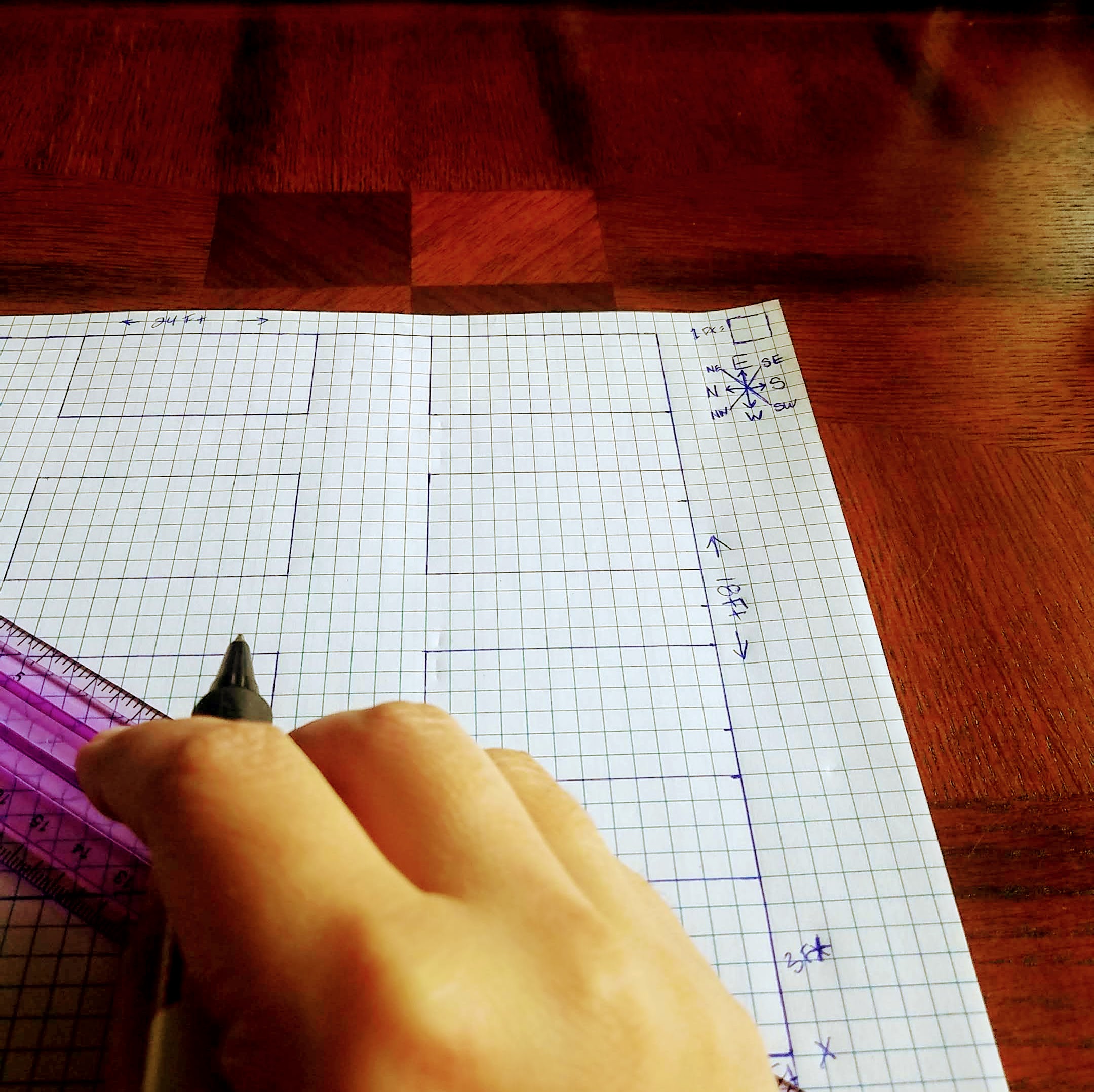Garden Planning 101: For New Gardeners

When you’re a new gardener where do you begin with garden planning? Here I give you my step by step guide in garden planning 101.

Some think it’s as easy as poking a seed into the dirt and bam you have a garden. Unfortunately, it’s a bit more involved than that. The least amount of mistakes the better, no one wants to lose time with setbacks when it comes to gardening.
Here in the northeast, the seasons are shorter and cooler than in other areas of the country. But first, let’s take a step back to the beginning. Being prepared is the first rule for new and beginner gardeners. If you haven’t read my post on that click here.
There are many things that go into garden planning and hopefully, I can address some of those for you here. In my last previous post, I made some suggestions on how to be more informed and prepared for gardening. The best time for preparation is wintertime, this is the time to read, dream and plan.

Location, Location, Location!
The three things every plant needs to grow are Sun, Water and Nutrients. Too little of those they die, as well as too much, can do the same. If you’ve chosen a sunny location for what you are growing that’s a good start.
In the northeast growing seasons are short so obtaining the most amount of sunshine on the garden is critical. In warmer climates, you might want to limit that some. Most fast growing vegetables only need around 7 hours of full sun. Sun mapping is essentially going out on a sunny day and photographing the area you want to plant in. See what time the sunlight first hits your garden spot in the morning and last in the evening. Making sure you are getting a minimum of 7 hours of sunlight on your garden.
Too much sun can burn or wilt delicate plants, seedlings and transplants putting them into distress and possibly killing them. Not enough sun will slow their growth and delay their development. Which may keep the soil cool and moist which is a breeding ground for dampening off.

Feed me, Seymour, Feed me!
That movie quote might be lost on this generation. Sigh. Anyways, the next important thing for plants is nutrients, soil, or fertilizers. Any way you cut it they need to be fed just like anything or anyone else. Without proper nutrition, they can’t develop properly and they will go into distress. Which in the plant world is the equivalent of putting up a big red flag or flare. The only problem is no one comes to the rescue, except insects and disease.
Prevention is key and starting off with a proper soil Ph is going to save you a lot of heartache. Most vegetables grow best in 6 to 7ph soil. Soil tests are sometimes free from the garden center or you can purchase them for around $12 bucks. Soil test kits are a great investment.
Once you know the ph you can talk to your garden center/co-op to find out what amendments you will need to get the proper soil ph. Once you’ve gotten your soil and drainage issues resolved you will have to decide on the kind of gardening you will want to do. Mounds, Flat Rows, Boxes or Raised Beds?

So you think you can garden?
Now that you have the location and proper soil ph you think you can just plop those plants into the ground? Not so fast. You need to determine what you are planting your plants in. Mounds, Flat Rows, Boxes or Raised beds? There are pros and cons to them all.
In the Northwest where I’m from, Southern Oregon to be exact I had all the sun, no crazy cold winds, long growing season and very little rain in the summer. So mound gardening worked great for me. I could control the watering schedule and the sun kept my hills nice and warm and with little rain to erode my hills I was in pretty good shape.
Here in the Northeast, it’s a different story. The winds coming from the north are cold, sunshine is limited, growing seasons are short and heavy rains are constant. So raised beds are more suited to this area. Cold frames, hot boxes, greenhouses, cloches and every other kind of implement to cover beds to keep out the cold and keep in the warmth is utilized.
Flat rows are common among commercial farming operations and not really ideal for the average home gardener. Garden boxes are nice if you have limited space or need to move the plants to keep them in the sun. Just make sure the boxes are big enough for your plants and you have caster wheels on them for ease of movement.

Ready? Set? GO!
So now you have the location, soil and bed type chosen now what? Since you’ve already done your homework on your growing zone I will assume you’ve figured out what you can and can’t grow in your area. Once you’ve determined this you can purchase your seeds and plants.
Now that the boxes are built or beds made you want to make sure the soil is ready to receive the seeds. According to the last day of frost which would be for my area mid-May I want to make sure my soil is around 65-70F which will help my seeds propagate quickly.
To do this I will wet my soil well and then put plastic sheeting over the top and let it sit for a few days. The solar heat will warm the soil, force the weeds to grow and die. Once you remove the sheet the soil will be nice and warm and most of the weed seeds should be dead.

How does your garden grow?
So you’ve planted your seeds, given them a good amount of water and now you wait. This can be the hardest part because you will begin to doubt your ability to garden. 1 to 2 weeks can feel like an eternity. There are a few things you can do to speed up growth but venture at your own risk.
You’ll want to make sure the soil is well tilled, warm and damp. Once the seeds go in you can water them with some room temperature water. Then tent your beds with plastic, which can help create a greenhouse effect, make sure it’s tented to give the plants enough room to breathe.
Once you see the first true leaves you’ll want to remove the plastic altogether or you can cause them to dampen off. If you’re still pretty early in the spring season you can replace the cover before the last rays of sunlight isn’t on your garden to help retain some of that heat over the night. Just make sure to remove in the morning while there is still dew on the grass.

Well on your way.
So you’ve made it to having a garden full of little green plants. How do you keep this going? For the first few weeks after the second set of true leaves appear you’ll want to thin out your plants. Which I know can seem painful after all the work you put into growing them. But you’ll want to give them room to grow and flourish.
If the seeds were planted very close together you may have a hard time pulling them out so a nice pair of pruning scissors will help with this task. Just refer back to the spacing on the seed packets leaving behind only the biggest, strongest and healthiest seedlings.
For the next few weeks, once a week give them a misting of foliage fertilizer which is one tablespoon each of kelp tea and fish emulsions diluted in 2 gallons of water in a home and garden mist sprayer. Make sure when you do this it’s in the early morning while there is still dew on the grass and you cover the entire plant top and underside of leaves. You’ll want to shower after this I promise.
You can drop the foliar feedings to once every 2 to 3 weeks once the plants are established. On the days you foliar feed don’t water the plants. If you must water them do so at the base of the plant so as to not wash away your fertilizer.

Keeping on top.
Every morning you will be checking your plants to see if any are in distress. I go out in the morning with a little box and pick off any bugs I see as I don’t like to use pesticides and feed them to my chickens. I don’t have chickens now that I live in the Northeast but my parents do so I will take them over there.
Deep watering should be done once or twice a week to promote the roots to dive deep. If you water them every day lightly they will have a shallower root system. A good rule of thumb is this: a healthy plant won’t have distress, disease or insects. When plants go into distress from too much water, too little food, too much sun, rotten roots, etc they put off a pheromone that insects can smell miles away. Insects are just like predators, they love to attack, kill and eat the young, weak and sick. So keeping your plants healthy is the first line of defense.
If you do see a few insects you don’t recognize collect them and note which plant they were on. Look up the type of insect get to know them so you know what they are and what they like to eat. Now go back out and look at your plant and see if you see any signs of distress. Yellowed leaves, black spots, mold, other insects, is the soil damp and warm or cold and wet? If you see any of those signs look up natural organic ways to combat them.
As long as you are taking all these steps you will be well on your way to a beautifully healthy and productive garden in no time. As the season progresses I will be putting up newer up to date post so you can follow along with my Northeast gardening adventure. Make sure to subscribe so you don’t miss a post.

About The Author
Sandra
Related Posts
Marvelous Macaroni & Cheese
“All middle-income families use carbs to stretch meals, across any ethnic group –…
January 24, 2022The Power of Powdered Milk
“That I may perform the oath which I have sworn unto your fathers, to…
January 14, 2022


